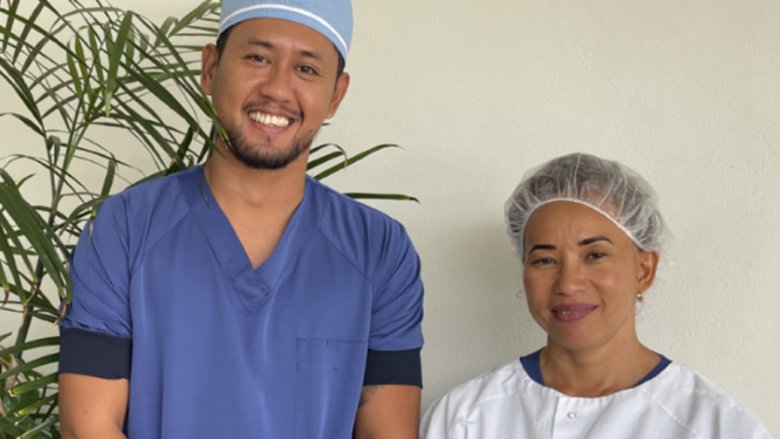After Category 5 Hurricane Irma hit Sint Maarten on September 6, 2017, everything was in chaos. Lorraine Tjinajoe, an operating room assistant staff supervisor at the Sint Maarten Medical Center (SMMC) recalled, “The country was a whole mess, everything [was] upside down. There was no garbage pickup; flies and mosquitoes were everywhere because there was no running water, no electricity. Everywhere and every corner were piles and piles of junk.”
As an SMMC staff member, Lorraine had been onsite at the hospital preparing for Irma’s approach. “All the medical staff on call had to stay on site to be ready to receive patients,” she said. Her unit prepared the operating room against storm damage by covering the medical and electrical equipment with plastic drapes. The SMMC building withstood the brunt of Irma’s impact, and the operating room remained largely untouched and operational, but the recovery efforts were hampered by the widespread devastation.
“We had limited stock for emergencies, but given the scope of Irma, everything was just at a standstill. We had no laundry coming in, no basic things that you are used to. We had to use our scrubs over and over, and plastic sheets, not the usual linens,” Lorraine recalled. Global supply chain constraints further slowed recovery efforts. “To serve the people of Sint Maarten, we had to get supplies from outside, but because the traffic into the island over air or sea had stopped, we could not get those supplies in time.
We ran out of basics like gloves and sutures,” noted Giovanni Diran, Lorraine’s colleague. He also explained that keeping everything running was dependent on how fast stocks came in, but the timing of deliveries depended on outside factors. And since Irma, the COVID-19 pandemic and the war in Ukraine have further strained supply channels, so the hospital tries to order as many supplies as possible to last between deliveries.
Building the Health Care Sector’s Preparedness and Resilience
As the only hospital in Sint Maarten, the nonprofit SMMC has worked to provide the best possible service despite external constraints. Following Irma, the Sint Maarten Trust Fund responded to the country’s need for improved hospital preparedness and service capacity and worked with the SMMC to launch the Hospital Resiliency and Preparedness Project, which includes the construction and launch of an improved SMMC facility.
To ensure minimal patient-care disruptions as the hospital upgrades its infrastructure and services, the project will follow a transition and contingency plan, with three key indicators to guide the progress. The first indicator is the number of overseas medical referrals required. Over the past five years, the SMMC has far exceeded expectations, reducing referrals by 91 percent. Although COVID-19 and related global movement restrictions influenced the data somewhat, the downward trend has held.
The second indicator involves implementing the Emergency Disaster Preparedness Plan and the Evacuation Plan. Accordingly, the SMMC is also involved in island-wide Emergency Support Function disaster evacuation preparedness sessions. Topics include activation and communication processes among first responders, patient evacuation protocols and procedures, and regional disaster response collaboration. Other ongoing activities include departmental emergency drills focused on the Fire Disaster and Safety Plan and the Emergency Disaster Preparedness Plan for key departments such as the intensive care unit, surgery, and pediatrics.
The third indicator relates to technical audits, which assess the implementation of clinical practice guidelines and quality control mechanisms in selected cases, in addition to the percentage of these cases that are rated as satisfactory.
Delivering Quality Health Care to the People of Sint Maarten
A lot of things have improved under the project. “I see that the hospital does a lot more quality checks as well to make sure everything follows protocol and is up to standard,” said Giovanni. The project has also helped to repair structural damage caused by Irma; increase the safety, preparedness, and overall resilience of the current hospital; expand the capacity of selected services (with new dialysis, chemotherapy, and operating rooms) and create new services such as ophthalmology, neurology, and urology; and add more patient rooms and beds.
“Our aim is to be the best on the island….we are working towards that so the population will be satisfied with the service we are providing. If there are things that need improvement, we are also looking at that as we evolve [in] to the Sint Maarten General Hospital in a few years from now. We are all in a learning process to better ourselves for the people, to give them the best service,” Lorraine said.



